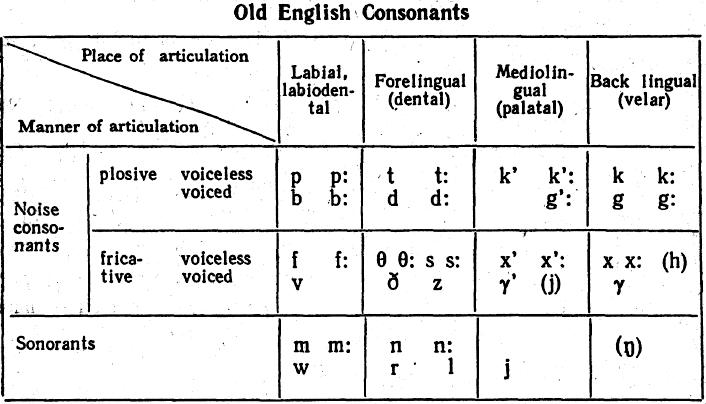
- •Lecture 7 old english phonetics Plan
- •Literature
- •Word Stress
- •Origin of old english vowels Changes of Stressed Vowels in Early Old English
- •Independent Changes. Development of Monophthongs
- •Development of Diphthongs
- •Assimilative Vowel Changes: Breaking and Diphthongisation
- •Old English Vowel System (9th-10th c.)
- •Origin of old english consonants Consonant Changes in Pre-Written Periods
- •Treatment of Fricatives. Hardening. Rhotacism. Voicing and Devoicing
- •Velar Consonants in Early Old English. Growth of New Phonemes
- •Loss of Consonants in Some Positions
- •Old English Consonant System
Old English Consonant System
Table 9 shows the system of OE consonants in the 9th and 10th.c.
The system consisted of several correlated sets of consonants. All the consonants fell into noise consonants and sonorants. The noise consonants were subdivided into plosives and fricatives; plosives were further differentiated as voiced and voiceless, the difference being phonemic. The fricative consonants were also subdivided into voiced and voiceless; in this set, however, sonority was merely a phonetic difference.
Table 9

between allophones. Cf. OE pin − bin, where the difference in sonority is phonemically relevant (NE pin, bin) and OE hl āf [f] − hlāford [v] where the difference is positional: the consonant is voiced intervocally and voiceless finally (incidentally, voiced and voiceless fricatives were not distinguished in OE spelling). The opposition of palatal and velar lingual consonants [k] − [k’], [g] − [g’] had probably become phonemic by the time of the earliest written records. (Some scholars include in the system one more palatal consonant: [sk’], spelt as sc, e. g. OE scip (NE ship); others treat it as a sequence of two sounds [s’] and [k’] until Early ME when they fused into a single sibilant [ʃ].) It is noteworthy that among the OE consonants there were few sibilants and no affricates.
The most universal distinctive feature in the consonant system was the difference in length. During the entire OE period long consonants are believed to have been opposed to short ones on a phonemic level; they were mostly distinguished in intervocal position. Single and geminated (long) consonants are found in identical phonetic conditions. Cf. OE lǽde −1st p. sg Pres. of lǽdan (NE lead) and lǽdde (Past); OE sticca (NE stick) − stica (Gen. case pl of OE stice, NE stitch). In final position the quantitative opposition was irrelevant and the second letter, which would indicate length, was often lacking, e. g. OE man and eal are identical to mann, eall (NE man, all).
